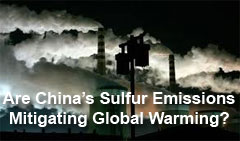A new paper from a trio of academics says that the 11-year slow down in global warming from 1998-2008 was the result of significant amounts of pollution coming out of China that - for now - is acting as a counterforce to rising levels of carbon emissions in the atmosphere.
Despite an increase CO2 emissions of almost 33% from 1998 to 2008, overall temperatures across the globe did not rise during the period, the researchers said in a new paper published this week in the Proceedings of the National Academy of Sciences. The report is authored by Robert Kaufmann and Michael Manna of Boston University, Heikki Kauppib of the University of Turku in Finland, and James Stock of Harvard.
Until now, "It has been unclear why global surface temperatures did not rise between 1998 and 2008," the researchers say. But, their new study claims this contradiction in the global warming community has been resolved, with the culprit being sulfur emissions coming primarily from coal-powered energy plants in Asia generally and China more specifically.
Sulfur allows water drops or aerosols to form, creating hazy clouds which reflect sunlight back into space, acting as a sort of heat shield for the planet.
"Anthropogenic activities that warm and cool the planet largely cancel after 1998, which allows natural variables to play a more significant role," the paper said.
Translated: The man-made activities of increased carbon emissions and man-made sulfur emissions basically cancelled each other out. Therefore, solar activity and other variable natural factors would be expected to be the main drivers of surface temperature levels, and those factors trended towards flat to downward pressure on the heat during the period.
 The report notes that "global surface temperatures indicate little warming between 1998 and 2008, and that global surface temperatures declined 0.2 degrees C between 2005 and 2008." The report notes that "global surface temperatures indicate little warming between 1998 and 2008, and that global surface temperatures declined 0.2 degrees C between 2005 and 2008."
We are not quite sure how to reconcile this data with other reports that 2010 was tied with 2005 as the warmest year on record, with the next the next warmest years being 1998, 2002, 2003, 2006, 2007 and 2009, according to NASA (see NASA Research Finds 2010 Tied for Warmest Year on Record). It seems impossible that global temperatures could have stayed flat from 1998-2008 with all these years in the same period of time being cited as the warmest on record.
"That is certainly a legitimate question," Robert Kaufmann, one of the report authors, told TheGreenSupplyChain.com. "Yes, there are two sources of temperature data. And yes, the peak year for temperature is different between the two series, but these differences are not statistically meaningful.To evaluate the effect of these differences, we performed our analysis with both sets of temperature data. The results were basically the same."
Given that the period of 1998-2008 saw rising concentrations of atmospheric CO2 and other greenhouse gases in the face of flat/declining temperatures, this fact "prompts some popular commentators to doubt the existing understanding of the relationship" among greenhouse gas emissions and global surface temperatures, the authors note.
"This seeming disconnect may be one reason why the public is increasingly skeptical about anthropogenic climate change," the report says, with the hope that their research will clear up this discrepancy.
The authors used an existing climate model to see if there is an explanation. That model showed that "net anthropogenic forcing [rising temperatures from man-made CO2 emissions] rises slower than previous decades because the cooling effects of sulfur emissions grow in tandem with the warming effects' greenhouse gas concentrations," largely netting each other out.
The prime source of these counteracting sulfur emissions is China's coal consumption, which doubled from 2003 to 2007 the report says. That is after a decline in overall sulfur emissions worldwide from 1990 to 2002 (a decline which, as the report notes, should actually have had a slight warming effect), the result of developed economies taking regulatory actions to reduce sulfur emissions up to and during that period. With warming (CO2) and cooling (sulfur) emissions largely cancelling each other out, natural forces would then control the day. Given the decline in certain solar activities, cooling effects from the impact of a change from El Nino to La Nina conditions (who knew?), and other natural factors, it makes perfect sense, say the authors, that global surface temperatures saw a small decline over the 10-year period. Should coal consumption decline globally in the future, the counterbalancing effects would be reduced or eliminated, and rising temperatures would be expected, the authors also note. Not said, but to us significant, is whether this model will prove accurate on a forward projection basis, not just a read view simulation. As many stock investors have learned, "past performance is not necessarily indicative of future results." Do you think this study will have any impact on the global warming debate? Does this analysis make sense to you, or do you have questions/issues? Let us know your thoughts at the Feedback button below.

TheGreenSupplyChain.com is now Twittering! Follow us at www.twitter.com/greenscm |